The Mole is "digging City Tunnel No. 3 far beneath Manhattan's street level, part of a 50-year, $6 billion project to upgrade New York City's water system."
 [Image: By Ozier Muhammad for The New York Times].
[Image: By Ozier Muhammad for The New York Times].As the New York Times describes, this is actually the "second phase of City Tunnel No. 3, a 60-mile tunnel that began in the Bronx in 1970 and is scheduled for completion in 2020. By then, the tunnel will be able to handle the roughly one billion gallons of water a day used in New York City that originates from rural watersheds to points throughout the city." And though the tunnel "is one of the largest urban projects in history, few people will ever see it. But beginning next week, many New Yorkers will certainly feel and hear the construction."
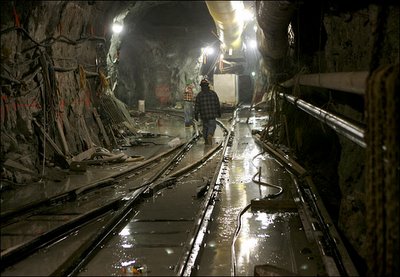

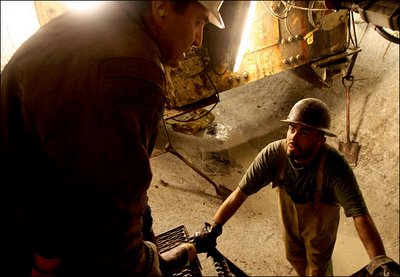 [Images: By Ozier Muhammad for The New York Times].
[Images: By Ozier Muhammad for The New York Times].The speed of the excavation process "varies based upon the hardness of the rock it encounters. The task of determining what type of rock lies in its path falls to Eric Jordan, a geologist hired by the city. By drilling down and hand-picking rocks from the tunnels, Mr. Jordan has created a precise map of the type of rock under Manhattan. His involvement in the tunnel project makes his geologist friends jealous. 'For a geologist,' he said, 'this is like going to Disneyland.'"
Jordan's "precise map" of Manhattan bedrock would indeed be something to see; but until then, we can make an educated guess about the rock his tunnel will find by turning to Richard Fortey.
In his highly recommended book, Earth, Fortey visits Central Park. First you notice the skyline of towers, he writes. "Then you notice the rocks. Cropping out in places under the trees are dark mounds of rock, emerging from the ground like some buried architecture of a former race, partly exhumed and then forgotten... That New York can be built so high and mighty is a consequence of its secure foundations on ancient rocks. It pays its dues to the geology. This is just a small part of one of those old seams that cross the earth... relics of a deeper time when millennia counted for nothing."
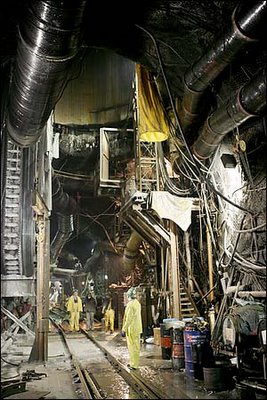 [Image: By Ozier Muhammad for The New York Times].
[Image: By Ozier Muhammad for The New York Times].John McPhee picks up this lithic line of thought in Annals of the Former World. Archipelago New York, he writes, is made of "rock that had once been heated near the point of melting, had recrystallized, had been heated again, had recrystallized, and, while not particularly competent, was more than adequate to hold up those buildings... Four hundred and fifty million years in age, it was called Manhattan Schist."
Of course, we can also turn to the U.S. National Geologic Map Database, and find our very own bedrock maps –
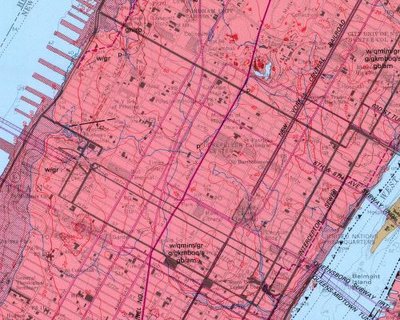
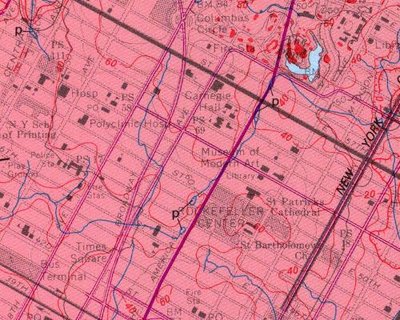
– which, awesomely, include Times Square, Carnegie Hall, Rockefeller Center, and the Museum of Modern Art, all floating above a sea of solid Manhattan Schist.
In any case, the new tunnel being dug to power the faucets of Manhattan are supplements to the pharaonic, 19th-century Croton hydrological network that keeps New York in taps (including the now derelict, yet Historically Registered, Old Croton Aqueduct). You can read about the Croton Dam, for instance, here or here; and there's yet more to learn about the Croton project, including how to follow it by trail, here.
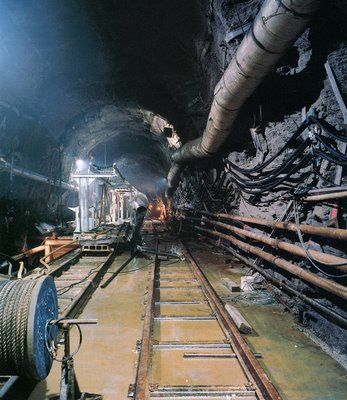 [Image: Photograph by Robert Polidori, from "City of Water" by David Grann, The New Yorker, September 1, 2003].
[Image: Photograph by Robert Polidori, from "City of Water" by David Grann, The New Yorker, September 1, 2003].Finally, in 2003 The New Yorker published an excellent article by David Grann called "City of Water," about, yes, City Tunnel No. 3. I'll quote from it here briefly before urging you to find a copy at your local library and read it for yourself.
Until Grann actually accompanied the tunnel workers – called sandhogs – underground, he "had only heard tales of New York City's invisible empire, an elaborate maze of tunnels that goes as deep as the Chrysler Building is high. Under construction in one form or another for more than a century, the system of waterways and pipelines spans thousands of miles and comprises nineteen reservoirs and three lakes. Two main tunnels provide New York City with most of the 1.3 billion gallons of water it consumes each day, ninety per cent of which is pumped in from reservoirs upstate by the sheer force of gravity. Descending through aqueducts from as high as fourteen hundred feet above sea level, the water gathers speed, racing down to a thousand feet below sea level when it reaches the pipes beneath the city."
Two main tunnels, he writes – and, thus, City Tunnel No. 3.
But I'll stop there – after I point out that toward the end of the ludicrously bad Die Hard III, Jeremy Irons temporarily escapes the less than threatening eye of Bruce Willis by driving out of Manhattan through similar such aqueducting tunnels.
(For more tunnels: See BLDGBLOG's London Topological or The Great Man-Made River; then check out The Guardian on London's so-called CTRL Project, with a quick visit to that city's cranky old 19th-century sewers, the "capital's bowels"... Enjoy!).
No comments:
Post a Comment